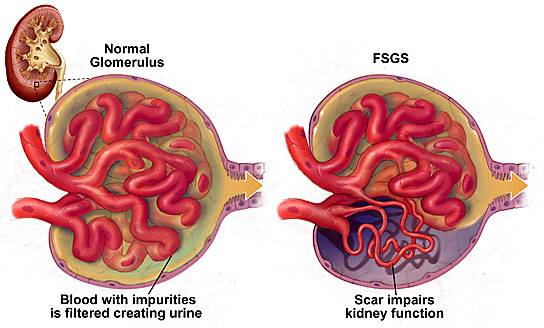Glomerulosclerosis - symptoms, diagnosis and treatment

What is Glomerulosclerosis and Definition
The formation of SCAR tissue (fibrosis) within the glomeruli, the coiled capillary networks within the nephrons of the KIDNEYS. The most common presentation of glomerulosclerosis is focal segmental glomerulosclerosis in which the fibrosis is scattered throughout the glomeruli, affecting only parts of the GLOMERULUS in various nephrons. The damage permanently blocks the affected glomeruli, however. Because the kidneys have millions of nephrons, glomerulosclerosis may be under way for a significant time before it causes enough damage to manifest symptoms. Some forms of glomerulosclerosis are familial (have a hereditary component) and others arise in conjunction with INFECTION such as HIV/AIDS. Most often, however, the glomerulosclerosis is idiopathic the nephrologist can find no cause for the scarring. Though some researchers believe the cause is autoimmune, glomerulosclerosis does not respond to IMMUNOSUPPRESSIVE THERAPY.
Symptoms of Glomerulosclerosis and Diagnostic Path
Early symptoms of glomerulosclerosis are vague and may not appear to be symptoms at all. They include
- poor APPETITE in combination with weight gain
- edema (swelling) of the face, hands and wrists, and feet and ankles
- foamy URINE, indicating ALBUMINURIA (excretion of ALBUMIN, a form of protein, in the urine)
- discolored urine, indicating HEMATURIA (BLOOD in the urine)
The diagnostic path begins with urinalysis, which typically reveals the albuminuria as well as hematuria. Needle biopsy of the kidney shows the fibrosis among the glomeruli and may also show the presence of Immunoglobulins characteristic of the condition. HYPERTENSION (high BLOOD PRESSURE) is also often present, a consequence of damage that affects the parts of the NEPHRON that produce a key HORMONE essential for blood pressure regulation (RENIN). Because the kidneys also produce ERYTHROPOIETIN (EPO), the hormone that stimulates the BONE MARROW to produce erythrocytes (red blood cells). Erythrocytes carry oxygen in the blood circulation. Progressive glomerulosclerosis often results also in ANEMIA (insufficient oxygen in the blood circulation).
Glomerulosclerosis Treatment Options and Outlook
There is no cure for glomerulosclerosis, which in most people progresses over about 10 years to END-STAGE RENAL DISEASE (ESRD). Treatment includes medications to control blood pressure. As CHOLESTEROL BLOOD LEVELS also tend to be high (HYPERLIPIDEMIA), the doctor may prescribe medications and lifestyle changes to help bring them down. These therapies may slow the progression of the fibrosis. The progressive loss of protein further damages the nephrons. At the point of ESRD, long-term RENAL DIALYSIS or KIDNEY TRANSPLANTATION is necessary to sustain life.
Glomerulosclerosis - Risk Factors and Preventive Measures
Glomerulosclerosis, particularly focal segmental, tends to develop in people who are in their 20s and 30s and is about three times more common among African American males. There are no measures to prevent glomerulosclerosis. Managing the symptoms as effectively as possible may delay the onset of ESRD. Kidney transplantation becomes the treatment option that offers the greatest opportunity for a return to normal activities.
See also GLOMERULONEPHRITIS; MEDICARE COVERAGE FOR PERMANENT RENAL FAILURE; NEPHROTIC SYNDROME.
Open discussion on the topic Glomerulosclerosis - symptoms, diagnosis and treatment
Similar interests
- Casino Non Aams
- Nuovi Casino
- Casinos Not On Gamstop
- UK Casinos Not On Gamstop
- Casinos Not On Gamstop
- UK Casinos Not On Gamstop
- Casino Non Aams Italia
- Slot Sites Not On Gamstop
- Meilleur Casino En Ligne
- Non Gamstop Casino Sites UK
- Meilleur Casino En Ligne
- Casino En Ligne France
- Best Non Gamstop Casinos
- Casinos Not On Gamstop
- UK Casino Not On Gamstop
- Casinos Not Signed Up To Gamstop
- Best Slot Sites UK
- Non Gamstop Casino Sites UK
- Online Casinos Nederland
- Online Casinos Nederland
- Casinos Not On Gamstop
- Best New Uk Casinos Not On Gamstop
- Casino Non Aams
- Non Gamstop Casinos UK
- Migliori Siti Casino Non Aams
- Bitcoin Casinos
- Sites De Paris Sportifs Belgique
- Bookmaker Non Aams
- Casino En Ligne
- Casino Français Sans Kyc
- Casino Nouveau En Ligne